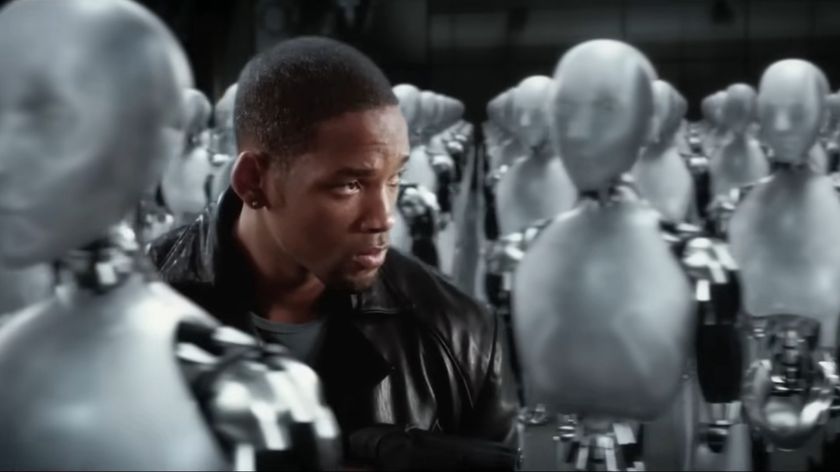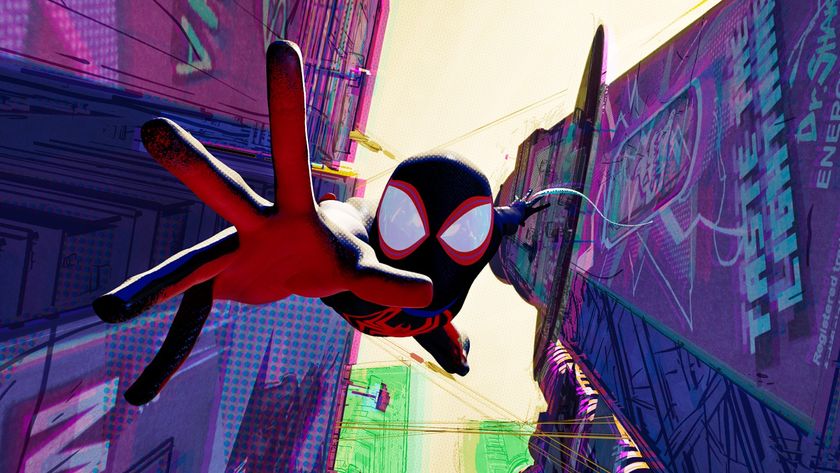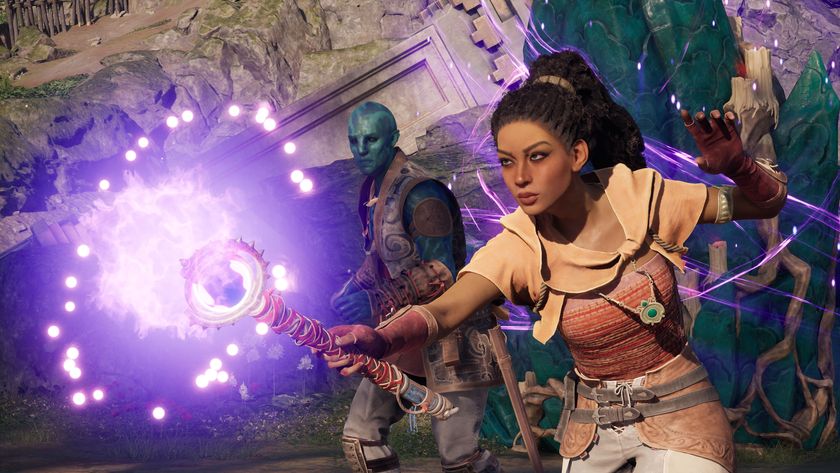The Lightyear cast and filmmakers take us inside Pixar's new sci-fi adventure
Exclusive: We talk all things Lightyear with the cast and filmmakers of Buzz's big screen adventure
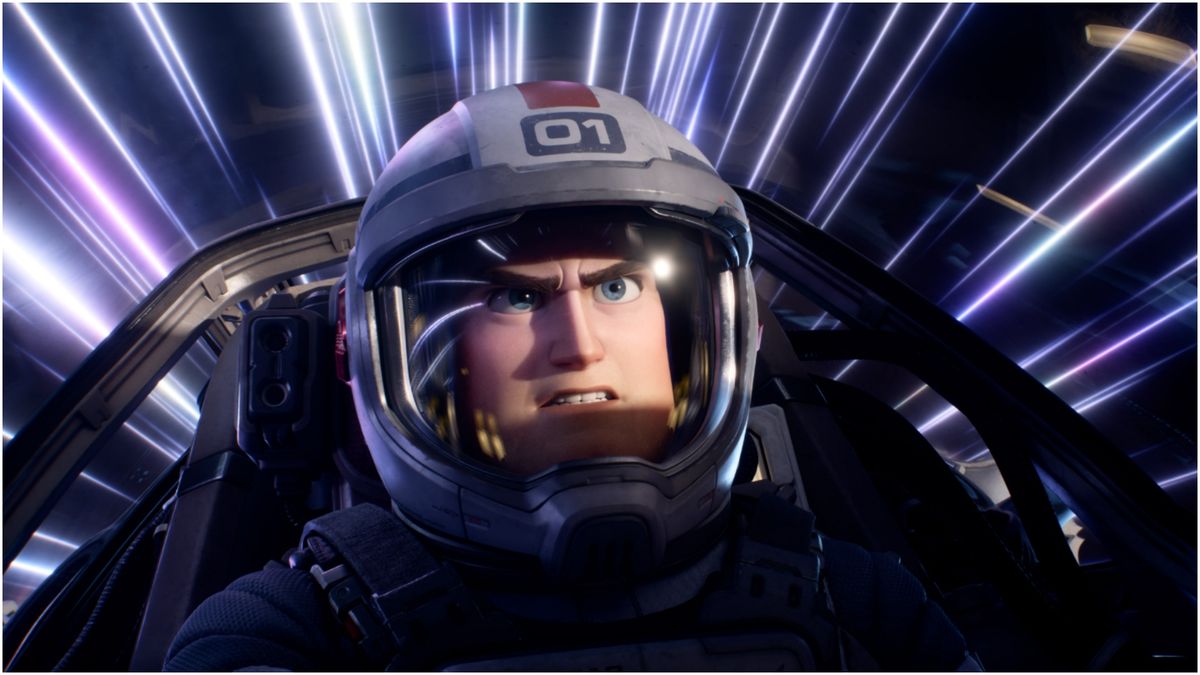
"There are things about Buzz and Toy Story that we knew we had to have," producer Galyn Susman tells Total Film. "He had to wear the suit, he had to have his purple snood, he was going to have a big chin and a dimple in that chin. And we knew that he would say 'to infinity and beyond,' and that there were elements from that first act of Toy Story that introduced that deluded Buzz that we definitely wanted to incorporate."
We're talking about Lightyear, the new Disney Pixar movie all about Space Ranger Buzz. This isn't the character as you remember him, though – as Susman explains, only the bare bones of Toy Story inspired the Buzz we see in the new film. "From there," she continues, "we needed to take a side character, turn him into a protagonist – a leading man – and go from there, give him flaws and surround him with people who make him face those flaws."
A toy's story
Lightyear isn't quite a Toy Story spin-off in the traditional sense. As the film's opening text explains, the action figure that Andy received as a birthday present back in 1995 was based on his favorite film – and Lightyear is that very film.
"I'd always been connected to Buzz Lightyear since I started at the studio in '97," says director Angus MacLane, who worked as an animator on Toy Story 2 and 3. "But I always felt like the backstory of Buzz hadn't been properly explored, and I felt like the backstory would be a movie. It would just have this sense of cinematic grandeur that we hadn't quite seen."
MacLane is no stranger to helming a Pixar film – he previously co-directed Finding Dory, and working on that project that helped him find his way to Lightyear. "After I had done Finding Dory with Andrew Stanton, I was trying to figure out the next thing to work on," he says. "And there was all this pressure of like, 'Let's do this really meaningful movie.' And I'm like, 'I just want to make a cool sci-fi movie that's really awesome.' And then, 'Wait, I could do the Buzz Lightyear movie that I always wanted to see.'
"And so it really was that simple. The first pitch was, 'What was the movie that Andy saw that made him want a Buzz Lightyear toy?' And why couldn't we just make that movie? Make a straightforward, sci-fi action adventure about Buzz Lightyear, an adventure with Buzz. And so that was the original pitch, and that was always the spirit in which we were going for, that at the end of the movie, the feeling the audience would have is like, 'Oh, that was fun.'"
Lightyear is indeed a fun sci-fi flick that sees Buzz stranded on a distant alien planet, T'Kani Prime, with some fellow interstellar explorers. They fight dangerous sentient vines, ginormous bugs, and, eventually, evil robots courtesy of the sinister Zurg (James Brolin). But Buzz is determined to get everyone back home. He sets out on a series of space flights in the hopes of unlocking hyperspeed travel… the catch is, every time he heads into hyperspace, time passes differently – in his first flight, a minute for him is four years back on T'Kani Prime. "The faster I fly, the further into the future I travel," Buzz summarizes. While he's off speeding through time, though, everyone else makes the most of their life on the planet, including Alisha Hawthorne (Uzo Aduba), Buzz's best friend and commander.
Sign up for the Total Film Newsletter
Bringing all the latest movie news, features, and reviews to your inbox
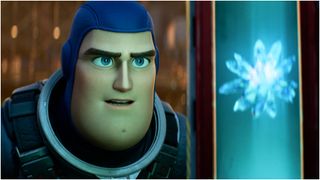
Since Lightyear isn't about Buzz the toy, a whole new voice actor has stepped into the Space Ranger's green and purple boots this time around: Captain America himself, Chris Evans. "I assured Chris that we didn't want him to impersonate Tim Allen, I wanted him to do his own version of the character," says MacLane.
As it turns out, Evans was the perfect choice to take on the task. "Very quickly, he relaxed and we got into the flow of it," MacLane explains. "And we ended up using stuff from the first session, which usually we don't, usually the first session is like, 'Well, okay, we'll figure it out.' But we used stuff right away, and he just got used to developing the character to have the [spot-on Buzz impression] 'sure voice when he would be very official, and he was reading the Buzz Lightyear Mission Log,' he would be a little bit more grandiose. And then when he would talk to Alisha, he'd be like, [another spot-on impression] 'Ah come on!' He would age down a little bit, be this little brother character to Alisha. And it was really those two extremes that we played with."
It's not just the voice that's changed, either. This version of Buzz is more prone to making mistakes – and he still has a lot to learn.
"The world has plenty of singular, heroic, 'Here I am to save the day' characters, and we were much more interested in telling a story with a character that has flaws and has growth to do," explains Susman. "And the message of the film, in part, is a message of teamwork, which doesn't really come naturally with a singular action hero, 'Save the day do it myself' kind of [character]. We were turning that on its head a little bit."
New friends
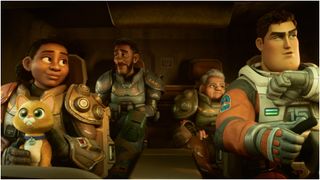
Teamwork is the name of the game in Lightyear. Buzz is joined on his mission by a lively cast of characters that form the "Junior Zap Patrol," a team of rookies the Space Ranger must reluctantly work with to have any hope of getting home. Foremost among them is Keke Palmer's Izzy Hawthorne, the granddaughter of Alisha (we told you time worked different in Lightyear).
"They have such a good relationship, Izzy and Buzz, because they're at two different places in their lives," says Palmer of her character. "Buzz is somebody that has always been successful as a Space Ranger and has a certain expectation and idea of who he is in the world, and what it means to be a hero. And you have Izzy, who's trying to fill the shoes of her grandmother, who was also Buzz's Space Ranger partner, Alisha. And she's trying to find her own identity outside of what it means to be a hero in terms of her grandmother's legacy, and so they really teach one another that being a hero, being a leader, means two different things at different times. And a big part of that is being a team player, and also knowing that it's okay to make mistakes."
Another member of the Junior Zap Patrol is Darby Steel (Dale Soules) – or "elderly convict" as Buzz calls her – a woman on parole with a mysterious past, and Buzz's adorable emotional support robot cat Sox (Peter Sohn), sure to steal the hearts of everyone who watches the movie.
Then there's Taika Waititi's Maurice "Mo" Morrison, who has a commitment problem that ties neatly into the film's major themes. "Mo, very similar to myself when I was in my early 20s, was just trying to find some focus, just trying to find his way through the world, as we all have when we were young," says an energetic Waititi. "It's not till later in life sometimes if you're a late bloomer like myself – and I do relate to Mo – that you actually find your path. So in a lot of ways, for Mo, it's about finding the confidence to make mistakes, the confidence to keep trying and to persist until you get it right. And I think that's really a theme with this whole film, is it's okay to make mistakes, one day it will happen for you."
Space Rangers
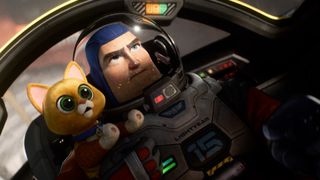
Buzz and these new pals are on a fantastical galactic mission in Lightyear, and, considering the film deals with sci-fi concepts like time dilation, interplanetary travel, hyperspeed, and AI technology, you might be surprised to discover that some of it is actually very true to life – as British astronaut Tim Peake, who has a voice cameo in the UK version of the movie, tells us.
"Loads of little nuances in it, yes, in terms of the accuracy," Peake says. "The weightless environment was really well modelled, you really get the feeling of 'Yeah, that's how the bodies move in weightlessness,' that feeling of pushing away and floating."
Some of the film's humor is even rooted in reality, too. "And then you've got the comedic element of space food, for example, being completely dull and boring, this horrible slab of meat that's fuel that Buzz is eating," laughs Peake. "And the Sox character, Sox is the emotional robot. Well, that's something that we do have on board the Space Station, an artificial intelligence robot up there that is helping us called C.I.M.O.N., not Sox, but it was brilliant to see." C.I.M.O.N., AKA Crew Interactive Mobile Companion, is head-shaped rather than cat-shaped.
The film also features another hallmark of the sci-fi genre: diversity. Lightyear has been banned in multiple countries over a same-sex kiss between Alisha and her wife, and both Alisha and Izzy are prominent Black characters.
"It was always part of the design," MacLane says. "Interestingly, thinking about it, I had always envisioned the world to be a reflection of our world, but to make sure that there was a diverse cast, mostly because that's what I was used to as a kid. The movie is very much meant to be this ideal sci-fi world, ideal sci-fi film, and the first sci-fi I saw the most of was actually Star Trek: The Original Series, which at the time was very diverse of its era. And so in the spirit of that, to show just a wide variety of diversity in the cast, that was just something that was always part of the story."
Waititi and Palmer also hope that this kind of diversity becomes increasingly more common. "Taika always makes a really good point that it will be great to get to the point where we don't even have to make big deals of these things, where it's expected to see LGBTQ+ representation, where it's normal to see women in power, Black women in power specifically," Palmer says. "The cool thing about our movie is that this is supposed to be the movie that made Andy fall in love with Buzz, right. And so in Toy Story, he had Buzz, and that's the only person you knew was part of the story. But now you realize that all these faces, all these people that have always been in our world are now prominent pieces of the story that we get to see. And that's the important part, because they've always been there."
…and beyond?
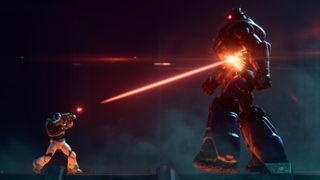
It's not a spoiler to say that Lightyear ends on a note that seems primed for a follow-up (and make sure you stay through the credits). But, don't expect to see Buzz and co. back anytime soon. "Well, I know what happens next, but I don't think I've told anyone," laughs MacLane. "This is a long process. If we were to make another one, I would be 95 by the time we finished it."
"When they're five and a half, six years, each film, you take a deep breath before you make a commitment on your next project," agrees Susman with a smile.
If this is the last time we see Buzz's adventures, then, Lightyear has more than enough fun, friendship, and eye-popping animation to keep us happy. All together now: to infinity…
Lightyear is in theaters now. For much more on the movie, check out our interview with Peake, as well as Susman on reinventing Buzz's iconic catchphrase.
Fill out your watchlist with our guide to the best movies on Disney Plus – and you can catch-up on the Toy Story movies on Disney Plus, too (and read up on how Lightyear and Toy Story are connected).
If you've seen the film already, get the lowdown on the Lightyear post-credits scenes and what they mean.

I'm a Senior Entertainment Writer here at 12DOVE, covering all things film and TV for the site's Total Film and SFX sections. I previously worked on the Disney magazines team at Immediate Media, and also wrote on the CBeebies, MEGA!, and Star Wars Galaxy titles after graduating with a BA in English.
Most Popular







